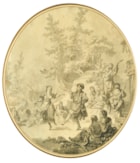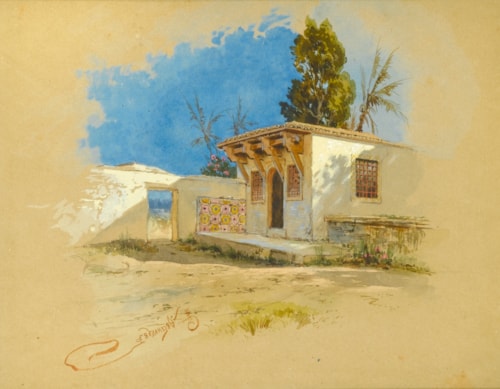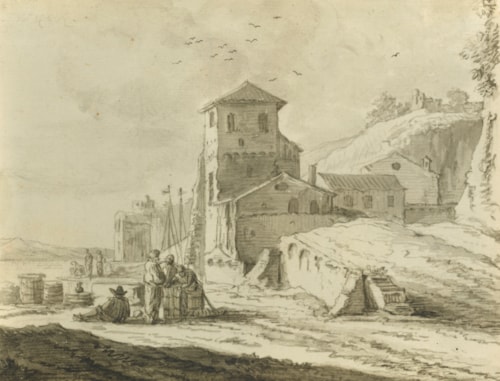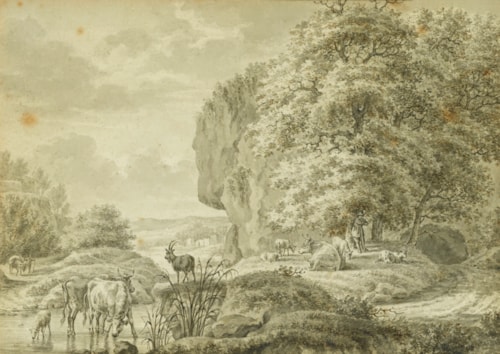ean-Baptiste Le Prince
(Metz 1734 - Saint-Denis-du-Port 1781)
A Russian Fête Champêtre
pen and black ink and grey wash, over traces of black chalk, on paper
oval; 38 x 33.5 cm (15 x 13⅛ in)
A Russian Fête Champêtre depicts a popular subject for Jean-Baptiste Le Prince and his contemporaries: a fête champêtre style party, where a couple dance in a leafy setting. While the term is derived from the French expression for a ‘pastoral festival’ or ‘country feast’ and, in theory, was a simple form of amusement, in practice, at least in the eighteenth century, a fête champêtre was often a very elegant form of entertainment involving on occasions whole orchestras hidden in trees, with guests sometimes in fancy dress. Le Prince’s work displays this theme in a completely Russian context: the variety of Russian folk costume and the depiction of a domra (a Russian string instrument) add exoticism to the scene.
Le Prince lived in Russia from 1758 to 1763, joining a large number of French artists who were working there, and teaching at the Imperial Academy of Arts in St. Petersburg. It seems that he travelled around the country a great deal, making sketches of Russian life which provided subjects for much of his work when he returned to France. Indeed Le Prince’s oeuvre contains many scenes of Russian dances. He received a major commission in 1764 to provide illustrations for the Abbé Jean Chappe d’Auteroche’s Voyage en Sibérie, a deluxe publication which helped encourage the fad for ‘russeries’. Le Prince’s work shows the influence of his French predecessor Jean-Antoine Watteau (1684-1721), who was known for his lyrical depictions of gentlemen and ladies engaged in intimate conversation with music in park-like settings, such as his Fête Champêtre. Watteau’s figures are depicted in a graceful and poetic manner, consistent with the light-hearted style of Rococo art. This style can also be seen here in Le Prince’s A Russian Fête Champêtre, which is drawn with elegant form and with a delicate, balanced composition. Another key comparison is the work of Jean-Honoré Fragonard (1732-1806), a French painter and printmaker whose late Rococo manner was distinguished by remarkable facility, exuberance, and hedonism. One of the most prolific artists active in the last decades of the ancien régime, he executed many genre paintings conveying an atmosphere of intimacy and veiled eroticism, which are amongst his most popular work. These characteristics can also be seen in Le Prince’s work, similarly created in the decadent Rococo manner which marked the last decades of pre-French Revolution frivolity.
Le Prince became famous for creating a new kind of genre picture, based on the direct observation of Russian subjects, and also for perfecting aquatint technique. Sometime around 1750 he became a pupil of François Boucher (1703-1770), thanks to the patronage of the Maréchal de Belle-Isle (1684-1761), Governor of Metz. Boucher’s saturated brushwork, highly finished surfaces and incisive drawing had a decisive impact upon the young artist, as did, perhaps, the diversity of his output. Le Prince was also inspired by seventeenth-century Dutch and Flemish genre and landscape painters. By July 1757 Le Prince had arrived in St. Petersburg. Well received by the French envoy, the Marquis de l’Hôpital, he received over forty commissions to execute overdoor pictures for the Empress Elizabeth (1709-1762) in the newly constructed Winter Palace, and further orders from Peter III (1728-1762). Le Prince is said to have travelled extensively in Russia, according to some as far as Siberia, and his prints show a knowledge of the north-western and western Empire. The drawings he made in Russia provided the basis for a considerable body of work that added to the general taste of the eighteenth century for exotica.
Many scenes of Russian dances are known in Le Prince's oeuvre, but the present drawing is very close in composition to a painting formerly in a private collection, New York.¹
¹ See Rorschach, K., Drawings by Jean-Baptiste Le Prince for the 'Voyage en Sibérie', exhibition catalogue, (Philadelphia, Rosenbach Museum and Library, 1986), p. 34, no. 38, reproduced.
Jean Cailleux (bears his collector's mark, not in Lugt)
London, Matthiesen Gallery, Exhibition of French Master Drawings of the 18th Century, n.d., no.45;
Paris, Galerie Cailleux, Eloge de l'Ovale, 1975, no. 17
A Russian Fête Champêtre depicts a popular subject for Jean-Baptiste Le Prince and his contemporaries: a fête champêtre style party, where a couple dance in a leafy setting. While the term is derived from the French expression for a ‘pastoral festival’ or ‘country feast’ and, in theory, was a simple form of amusement, in practice, at least in the eighteenth century, a fête champêtre was often a very elegant form of entertainment involving on occasions whole orchestras hidden in trees, with guests sometimes in fancy dress. Le Prince’s work displays this theme in a completely Russian context: the variety of Russian folk costume and the depiction of a domra (a Russian string instrument) add exoticism to the scene.
Le Prince lived in Russia from 1758 to 1763, joining a large number of French artists who were working there, and teaching at the Imperial Academy of Arts in St. Petersburg. It seems that he travelled around the country a great deal, making sketches of Russian life which provided subjects for much of his work when he returned to France. Indeed Le Prince’s oeuvre contains many scenes of Russian dances. He received a major commission in 1764 to provide illustrations for the Abbé Jean Chappe d’Auteroche’s Voyage en Sibérie, a deluxe publication which helped encourage the fad for ‘russeries’. Le Prince’s work shows the influence of his French predecessor Jean-Antoine Watteau (1684-1721), who was known for his lyrical depictions of gentlemen and ladies engaged in intimate conversation with music in park-like settings, such as his Fête Champêtre. Watteau’s figures are depicted in a graceful and poetic manner, consistent with the light-hearted style of Rococo art. This style can also be seen here in Le Prince’s A Russian Fête Champêtre, which is drawn with elegant form and with a delicate, balanced composition. Another key comparison is the work of Jean-Honoré Fragonard (1732-1806), a French painter and printmaker whose late Rococo manner was distinguished by remarkable facility, exuberance, and hedonism. One of the most prolific artists active in the last decades of the ancien régime, he executed many genre paintings conveying an atmosphere of intimacy and veiled eroticism, which are amongst his most popular work. These characteristics can also be seen in Le Prince’s work, similarly created in the decadent Rococo manner which marked the last decades of pre-French Revolution frivolity.
Le Prince became famous for creating a new kind of genre picture, based on the direct observation of Russian subjects, and also for perfecting aquatint technique. Sometime around 1750 he became a pupil of François Boucher (1703-1770), thanks to the patronage of the Maréchal de Belle-Isle (1684-1761), Governor of Metz. Boucher’s saturated brushwork, highly finished surfaces and incisive drawing had a decisive impact upon the young artist, as did, perhaps, the diversity of his output. Le Prince was also inspired by seventeenth-century Dutch and Flemish genre and landscape painters. By July 1757 Le Prince had arrived in St. Petersburg. Well received by the French envoy, the Marquis de l’Hôpital, he received over forty commissions to execute overdoor pictures for the Empress Elizabeth (1709-1762) in the newly constructed Winter Palace, and further orders from Peter III (1728-1762). Le Prince is said to have travelled extensively in Russia, according to some as far as Siberia, and his prints show a knowledge of the north-western and western Empire. The drawings he made in Russia provided the basis for a considerable body of work that added to the general taste of the eighteenth century for exotica.
Many scenes of Russian dances are known in Le Prince's oeuvre, but the present drawing is very close in composition to a painting formerly in a private collection, New York.¹
¹ See Rorschach, K., Drawings by Jean-Baptiste Le Prince for the 'Voyage en Sibérie', exhibition catalogue, (Philadelphia, Rosenbach Museum and Library, 1986), p. 34, no. 38, reproduced.
Jean Cailleux (bears his collector's mark, not in Lugt)
London, Matthiesen Gallery, Exhibition of French Master Drawings of the 18th Century, n.d., no.45;
Paris, Galerie Cailleux, Eloge de l'Ovale, 1975, no. 17




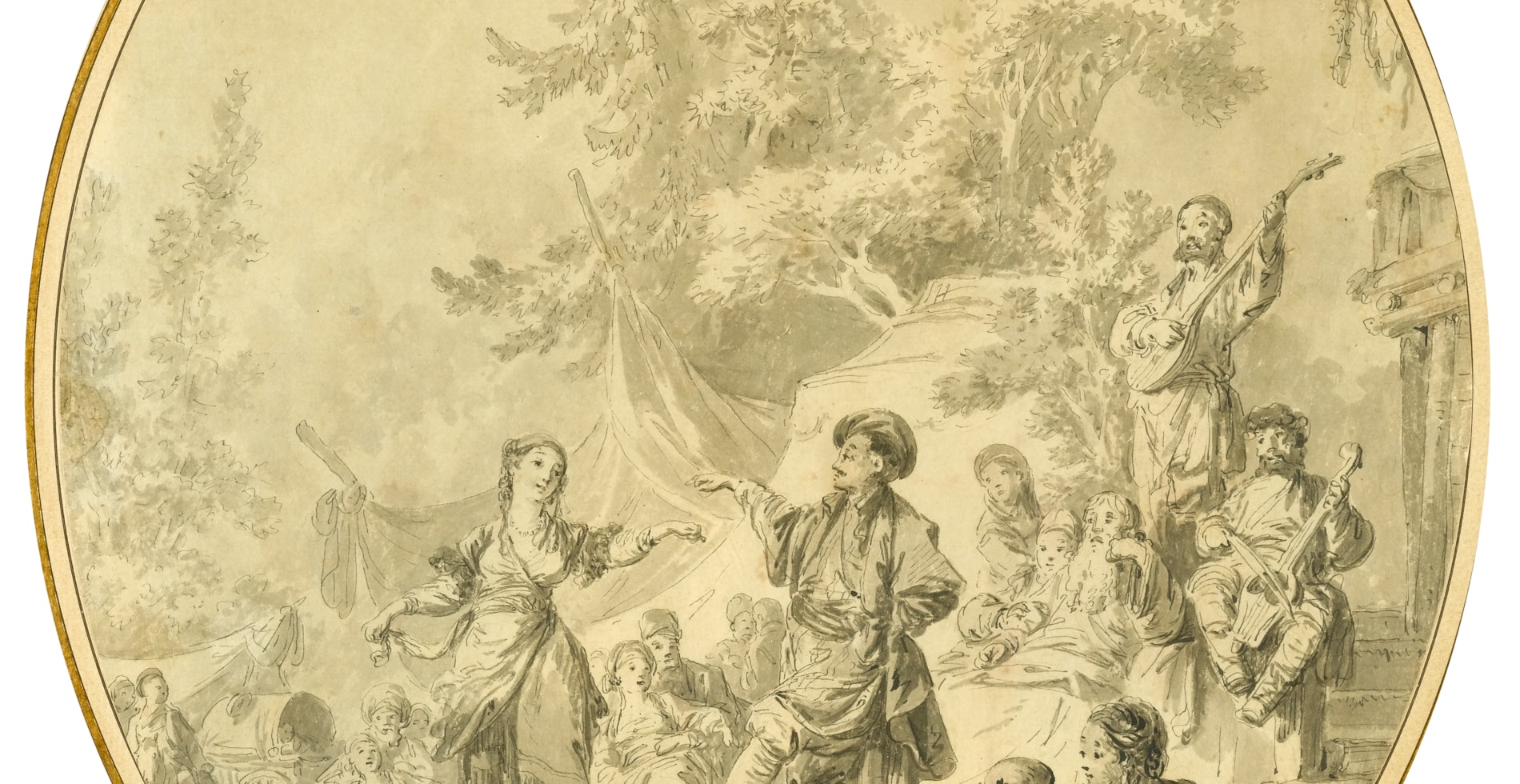
 contact
contact contact
contact +44 20 7313 8040
+44 20 7313 8040